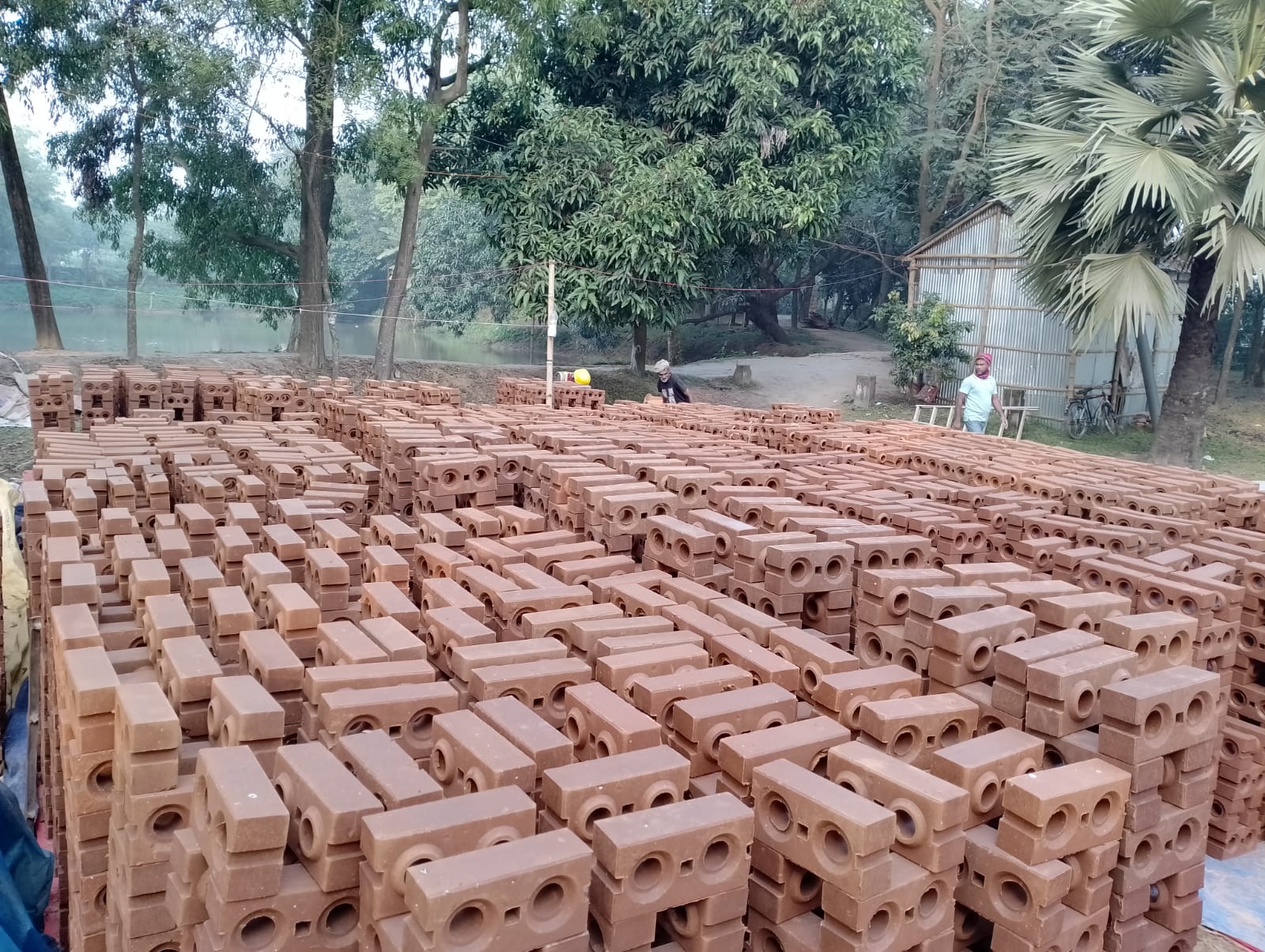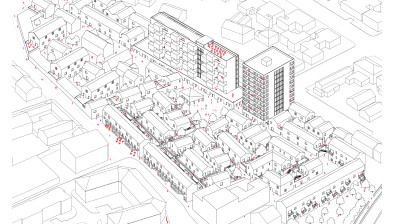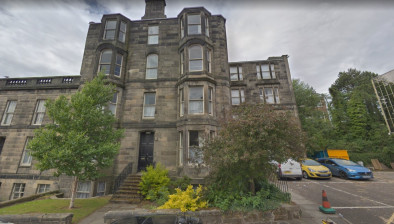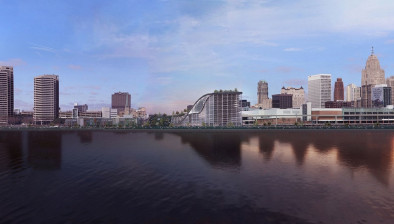Disaster resilient homes: the Dundee design that could save communities
A completed disaster-resilient home in Dhaka, Bangladesh
A new University of Dundee design concept can help communities threatened by extreme weather events fight back in the battle against climate change.
The sustainable properties, designed to cope with flooding and other climate emergencies, are appearing in Dhaka, the capital of Bangladesh, in the latest evolution of a housing concept developed thousands of miles away on the banks of the River Tay.
As well as having the ability to float, the properties can produce their own power and grow food, allowing communities that would otherwise face displacement to remain resolute in the face of increased rainfall.
The first of these Dundee-designed demonstration properties have now been completed in Dhaka, giving hope to those who live at the mercy of the elements.
A demonstration home under construction
“The communities that we have been working with are ecstatic about what they are seeing,” says Roufa Khanum, from the Resilience Solution and Centre for Climate Change and Environmental Research (C3ER) of BRAC University, which is working with Dundee experts.
“Conventional housing typically prioritises aesthetics and functionality over environmental considerations. These homes, however, are designed with a focus on sustainability, energy efficiency, and minimising environmental impact, while being three to four times cheaper than conventional homes in the city.
“The ultimate goal of scaling up the concept of climate-resilient homes in Bangladesh and elsewhere is to offer self-reliance to climate ‘at-risk’ communities. By providing education and training, access to resources, advocacy and representation, support networks, and information and communication, individuals can be empowered to take control of their lives.”
While the concept homes may look similar to traditional “box” style homes seen throughout the world, Dr Nandan Mukherjee, of Dundee’s UNESCO Centre for Water Law, Policy and Science, says that construction has only been possible due to development of a revolutionary brick which has further improved the project’s environmental credentials.
Aquaponics systems allow households to produce their own food
“Nature has been a great teacher and it has ultimately taken two years to develop this new brick,” he says.
“When soil is compressed with sand it turns into a semi-stone. We used clay soils, which have natural binding properties, as well as additives like lime that promote a chemical reaction, not a thermal reaction, that creates a mineral complex. This negates the requirement to toast the brick, but also draws carbon dioxide out of the atmosphere, which is beneficial to the environment.
“This is science and technology coming together, which as a university is hugely enjoyable to have witnessed.
“Our first disaster-resilient homes were built from bamboo, which is often referred to as ‘poor person’s timber’. From extensive community consultation exercises, it became clear that people want to live in ‘box’ houses, constructed with a recognisable type of brick.
“Box architecture is prevalent everywhere from Africa to America, as well as here in the UK. Climate change is a global problem, so it makes sense to create a design that can be replicated anywhere.”

The so-called 'Dundee brick' is stacked ahead of construction
Around 40% of the world’s population live in coastal areas less than 100 km from the sea. As the world struggles to adapt to climate change there is an urgent need to help these inhabitants deal with rising sea levels, heavy rainfall and increasing numbers of natural disasters such as extreme flooding.
In Bangladesh, some 45 million people live in areas where extreme cyclones frequently destroy homes and livelihood assets, causing further complex social and economic challenges.
In 2017, Dr Mukherjee, then a PhD student at Dundee, developed the initial disaster-resilient home. Costing $12,000 each, the properties could produce their own food, water and energy, using permaculture-based food production systems and renewable energy generation. Furthermore, they were capable of floating, allowing communities to remain resolute in the face of floods and cyclones, issues becoming increasingly prevalent as climate change tightens its grip on the planet.
Two years later, the concept won the United Nation’s prestigious Risk Award, accompanied by the award of $100,000 prize fund supporting a Research Fellowship to develop the concept further. This additional funding to the UNESCO Water Centre has resulted in the new, full-scale demonstration home, located in the Bangladeshi capital.
Designed to be replicated anywhere in the world, the homes utilise bricks that can also incorporate fibres and materials specific to regions. Dundee was once a famous hub for the global jute trade, and this is one fibre that can easily be incorporated into the brick design to strengthen it further. In a twist of fate, could the material that helped build Dundee now help Dundee build the rest of the world?
“Our bricks are comparable in strength to a conventional brick, and cost just a third of the price,” added Dr Mukherjee.
“We also found that including fibres such as jute or bamboo to our formula meant they could be strengthened further.
Bamboo is prepared in a workshop ahead of its use in construction
“This will be our next avenue of exploration, where we will study how other natural fibres can be incorporated into the construction process. Doing this successfully allows us to develop further nature-based solutions, making our homes stronger, more durable, and even more sustainable.”
The creation of the concept homes in Dhaka provided the opportunity for around 100 local people to be trained in the construction process. While acknowledging that overcoming scepticism will be a factor, Professor John Rowan, director of UNESCO Centre for Water Law Policy and Science, said that the concept has the potential to revolutionise house design for communities at risk from climate change.
“When something is cheaper, people often believe that it is an inferior product,” he said.
“As educators, we need to tell the world that this is not the case in this instance. There are clearly sensitivities about how this concept can be rolled out because it has the potential to disrupt the conventional construction market. However, we are committed to help deliver the UN’s 17 Sustainable Development Goals and we believe that this project addresses each one in important ways.
“In the short-term, we need to illustrate the potential of this concept, demonstrate its success and then allow others to utilise it. We are not trying to control the market and establish a construction spinout. This is a global concept and one we want to gift to the world.”
- For more on designing homes for displaced people in the aftermath of disasters, check out the next episode of the Scottish Housing News Podcast which is due to be published on Monday, December 4.























